Apple Crisp Artisan Sourdough Bread
Equipment
- Tovolo spatula (for feeding your starter)
- 3/4 L Weck jar (for your starter)
- Stand mixer (optional)
- Square dish (or a mixing bowl)
- Danish dough whisk (if hand mixing)
- Box grater (for shredding the apple)
- Oval banneton (medium oval from Flourside is my favorite)
- Flour sack towels (for lining your banneton, in case of leaks)
- My favorite bread bags (good for storing at home or gifting)
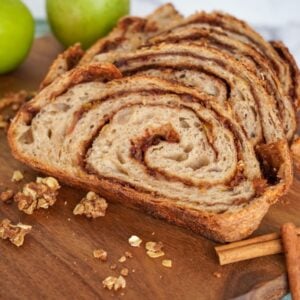
Ingredients
Starter
- 12 g sourdough starter
- 60 g water
- 60 g bread flour
Main Dough
- 150 g apple cider (we will reduce this on the stovetop)
- 1 medium green apple (1 apple is ~140g whole and 100g shredded)
- 210 g water
- 120 g active sourdough starter (from above)
- 5 g vanilla extract (optional)
- 1/2 tsp cinnamon
- 1/4 tsp each of nutmeg and ginger*
- 1/8 tsp each of allspice and cardamom*
- 500 g bread flour
- 10 g salt
Filling
- 70 g packed brown sugar
- 20 g bread flour
- 1 tbsp cinnamon
- 1/2 tsp nutmeg*
- 1/4 tsp each of ginger and allspice*
- 58 g butter (softened)
- 40 g freeze-dried apple or apple chips (optional)
Crumble (Optional)
- 23 g bread flour
- 23 g brown sugar
- 12 g old-fashioned rolled oats
- 1/4 tsp cinnamon
- Pinch of nutmeg
- Pinch of salt
- 17 g cold butter, cubed
- 2 tsp apple cider
Instructions
Feed Your Starter
- The night before making your dough, feed your starter a 1:5:5 feeding ratio by mixing 12 g sourdough starter, 60 g water, and 60 g bread flour. This gives you a few extra grams, so you don’t have to scrape the jar clean (use the leftovers to maintain your starter). At this ratio, your starter should peak in 10-12 hours. Starting in the morning? Use a 1:1:1 ratio for a faster peak time (4-6 hours): 45g starter, 45g water, 45g bread flour. Scale up for multiple loaves.
Reduce Apple Cider & Prepare Apple
- In a small saucepan over high heat, bring 150 g apple cider to a rolling boil. Let boil for 4-5 minutes, or until reduced by about half. We need 60 g of our reduced apple cider for this recipe (for one loaf). Let cool to room temperature before proceeding.
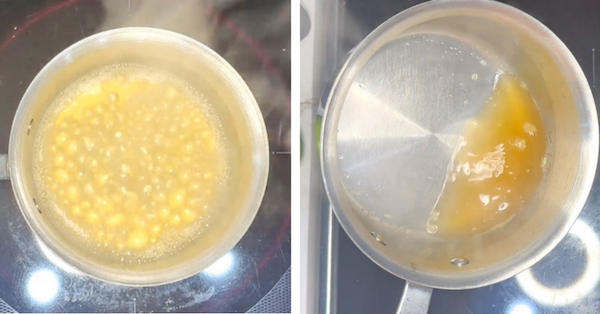
- Using a box grater, coarsely shred 1 medium green apple (unpeeled). One apple should yield about 100 g. Shred just before adding to dough – prepping ahead causes the apple to brown.
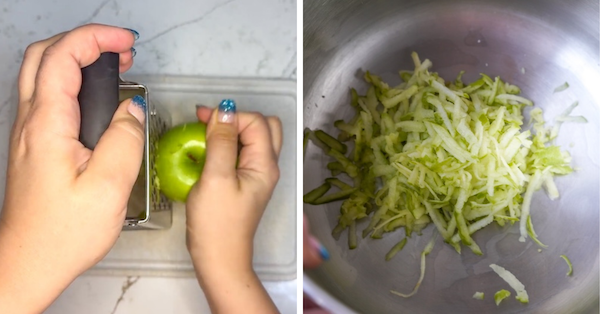
Mix
- You can mix this dough by hand with a Danish dough whisk or in your stand mixer fitted with a dough hook. We will still develop gluten and strengthen the dough by hand, but a stand mixer makes easy work of the initial mix.In a large glass bowl or a stand mixer bowl, combine our reduced apple cider (60 g for one loaf), the shredded apple, 210 g water, 120 g active sourdough starter, 5 g vanilla extract, 1/2 tsp cinnamon, 1/4 tsp each of nutmeg and ginger*, 1/8 tsp each of allspice and cardamom*, 500 g bread flour, and 10 g salt.
- If mixing by hand, use a Danish dough whisk to get the ingredients mostly incorporated. Then, switch to your hands, squeezing and kneading the dough until fully combined (3-4 minutes total).If using a stand mixer, mix for 3-4 minutes at a low speed, or until all ingredients are fully combined.

- Texture check! Please reference this video and add either additional flour or liquid, if needed, to achieve the desired dough texture.
- Pro tip: Transfer your dough to a square or rectangular dish instead of a round bowl. This makes stretch and folds easier and sets you up for success when shaping the dough into a rectangle later!
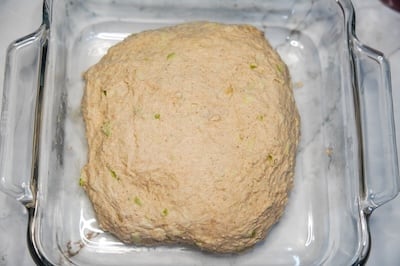
- Cover with plastic wrap and let rest for 30-60 minutes. Set out 58 g butter to soften for the filling later.Note: this is the beginning of the bulk fermentation.
Strengthen
- We will do four rounds of dough strengthening, each separated by a 30-60 minute rest. For the first three rounds, I like doing stretch and folds. For the final round, I like switching to coil folds, which are gentler.How to do stretch and folds: Wet your hands, grab one side of the dough, stretch it up and fold it over to the opposite side. Rotate the bowl 90 degrees and repeat. Continue until you’ve folded all four sides. I will personally keep stretching and folding the dough until it resists.

- How to do coil folds: Lift the dough from the center, let the edges drape down, and tuck them underneath as you set it back down.
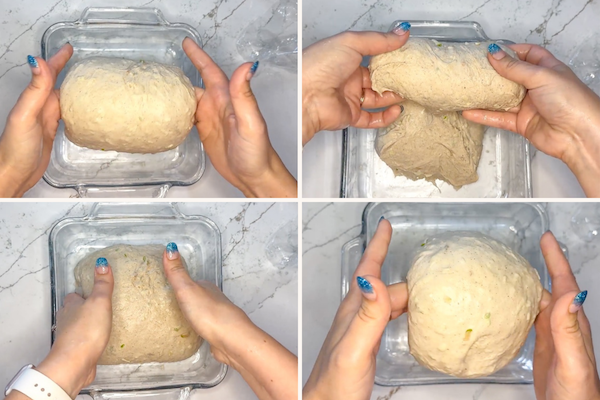
Bulk Ferment
- Let the dough finish bulk fermenting until it is bubbly, jiggly when you shake the bowl, feels light and aerated when you tap the surface, and if you pull at the edge of the dough, you see some gluten strands.For reference, this took 5.5 hours when my dough was 75°F (23.8°C), and in another test, it took just over 6 hours when my dough was 74°F (23.3°C). See Notes for a full timeline.
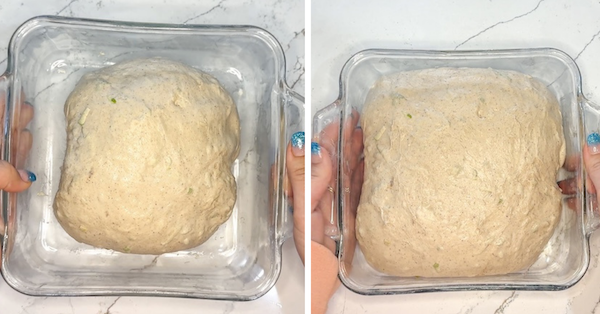
Shape
- Prepare the filling: In a medium-sized bowl, combine 70 g packed brown sugar, 20 g bread flour, 1 tbsp cinnamon, 1/2 tsp nutmeg*, and 1/4 tsp each of ginger and allspice*. Then, add 58 g butter (softened). If the mixture isn't spreadable, warm it in the microwave for 5-10 seconds.
- Lightly flour your work surface. Dump out your dough and gently stretch it into a rectangle, taking care not to de-gas the dough as much as possible.
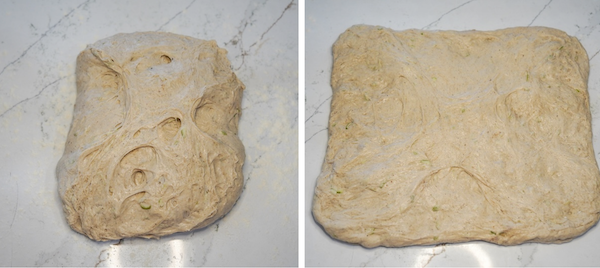
- Spread half of the filling evenly across your dough rectangle, leaving a gap at the edges. Crunch up your 40 g freeze-dried apple or apple chips into smaller pieces and sprinkle half of them on top.

- Fold the dough’s sides to the center and pinch the seams closed. I like to gently dimple the dough the restribute any gas bubbles. I also will gently stretch the rectangle to be slightly wider, if needed.
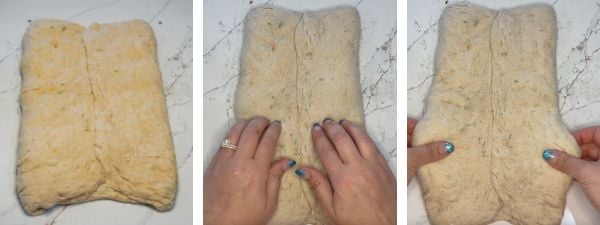
- Spread the remaining filling along the new center, leaving a gap around the edges for sealing. Sprinkle on the remaining half of your freeze-dried apples or apple chips.
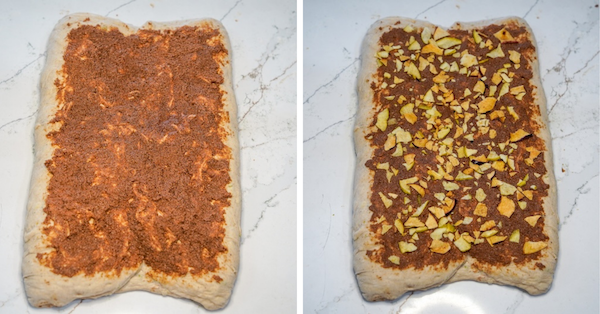
- Roll the dough tightly into a log, pinching the edges to seal as you roll.
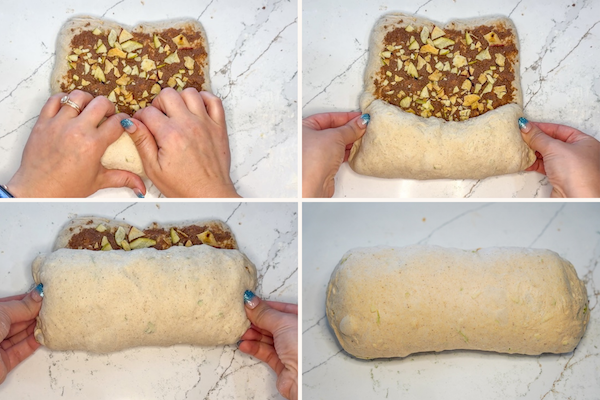
- Optional step (not photographed): For an oat-crusted exterior, mist shaped dough with water and roll in old-fashioned oats before placing in banneton.
- Place seam-side up into a towel-lined banneton (take precautions as it could leak a little). Let relax for 15-30 minutes (you can let it rest longer if you feel it needs more fermentation time); then, pinch the center seam closed. Cover and refrigerate overnight.
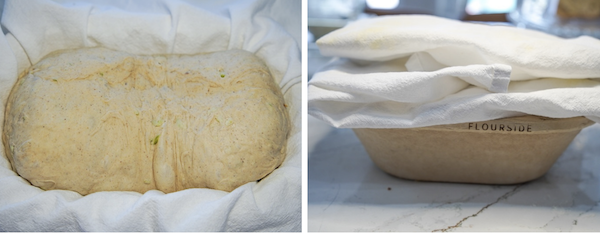
Score & Bake
- Score & bake: The next day, preheat your oven to 450°F (230°C) convection (or 475°F/250°C conventional) with a Dutch oven inside.
- Flip the dough onto parchment paper and score the top straight down the center, taking care not to score too deep.
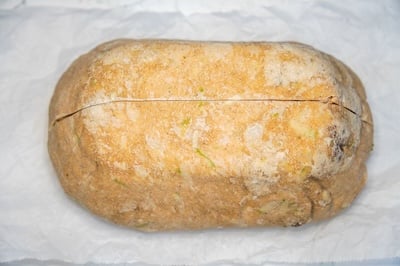
- Bake for 40 minutes, covered. Note: 26% of recipe testers reported a burnt bottom. Consider placing a sheet tray on the rack directly below your Dutch oven to deflect some of that heat.
- Prepare the crumble (optional): While the loaf is baking, in a small bowl, combine 23 g bread flour, 23 g brown sugar, 12 g old-fashioned rolled oats, 1/4 tsp cinnamon, Pinch of nutmeg, and a Pinch of salt. With a fork (or your fingers), mash in the 17 g cold butter, cubed. Add 2 tsp apple cider and mix together.Note: The crumble will fall off when you slice the loaf – we like to butter our slice and sprinkle the fallen pieces on top! Skip the crumble if you prefer mess-free slicing.
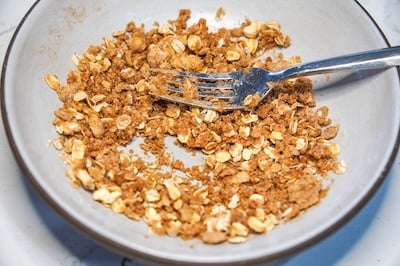
- After the 40-minute covered bake, remove the lid and check the internal temperature. It should be between 190-200°F (88-93°C) – if not, cover and check again in 5 minutes. Then, press on your prepared crumble (optional).
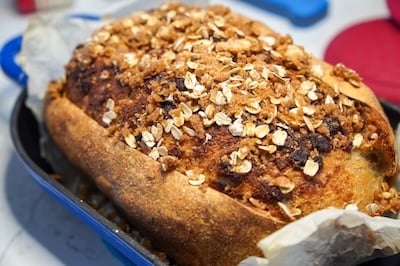
- Bake for 5-15 minutes more, uncovered, or until it's golden brown with an internal temperature of 205-210°F (96-99°C).Tent with foil or re-cover with your Dutch oven lid if it's getting too dark on top. If it's browning quickly but the internal temperature isn't getting close to done, lower the oven temperature to 425°F (220°C) for the remainder of the bake.
- Place baked loaf on a cooling rack and let it fully cool before slicing (about 1-2 hours). If you slice it warm, you may experience a gummy texture, and the loaf will become dry once cooled.
Notes
*Can swap for an equal amount of apple pie (or pumpkin pie) spice
Filling alternative: For a shortcut, swap the entire filling for 135g of apple butter with 2 tbsp of bread flour mixed in.
Dairy-free: Swap the butter for cool coconut oil.
My general timeline in a 73-76°F (23-25°C) home, for reference:
- 9am: Mix dough (bulk fermentation begins)
- 9:45am: Stretch and fold
- 10:15am: Stretch and fold
- 10:45am: Stretch and fold
- 11:30am: Coil fold
- 2:30pm: Make filling and shape (bulk fermentation ends)
- 2:45pm: Pinch seam and refrigerate
- Next day: Bake
Nutrition
Serving: 1 sliceCalories: 298kcalCarbohydrates: 53gProtein: 7gFat: 6gSaturated Fat: 3gPolyunsaturated Fat: 1gMonounsaturated Fat: 1gTrans Fat: 0.2gCholesterol: 13mgSodium: 370mgPotassium: 105mgFiber: 2gSugar: 11gVitamin A: 164IUVitamin C: 1mgCalcium: 27mgIron: 1mg